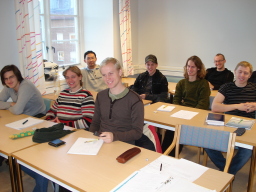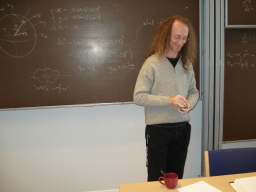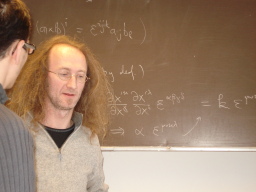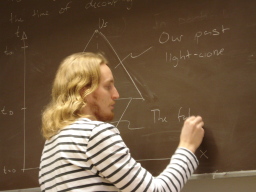Fundamental physics, year 1
(Teknisk fysik, årskurs 4)
Gravitation and Cosmology — Lecture notes
by Christian von Schultz
Lecturer: Martin
Cederwall
Assistant teacher: Fredrik
Ohlsson (exercise classes)
This is an introductory course in general relativity. The course
home page can be found at
http://fy.chalmers.se/~tfemc/Gravitation/.
- Monday 2008-10-27
- Introduction to the course. Newton's description of gravitation
— the analogy with electrostatics. Galilean
transformations. Lorentz transformations. Tensor notation. Lorentz
transformation as a linear transformation of the coordinates. The
postulates of special relativity. Light rays. The Minkowski
metric η. The transformation of vectors, scalars,
tensors. Raising and lowering indices with η.
- Tuesday 2008-10-28
- Special relativity: Velocity and four-velocity. Proper
time. Time dilation. Four-acceleration. Four-momentum. Taylor
expansion of E = γ m (or, restoring the speed of light, E
= γ m c2). Currents and
charges. The equation of continuity. Analogy between
electromagnetic charges/current and four-momentum/stress-energy
tensor (also known as the energy-momentum tensor). Maxwell's
equations [in relativistic (c =
1) Lorentz-Heaviside
units]. The electromagnetic field tensor. Maxwell's equations
in tensor notation. The four-vector
potential Aα. Curl using index notation.
- Thursday 2008-10-30
- Exercise
problems: Exercise class 1, problems 1–5.
- Monday 2008-11-03
- The equivalence principle. Dropping apples in accelerated
elevators. Inertial mass and gravitational mass. Physics in
Australia. Local inertial frames, local tangent planes, local
Minkowski space. General coordinate
transformations ξα
→ xμ, ηαβ
→ gμν. The affine
connection Γμνλ. The geodesic
equation. Expressing Γμνλ in terms of
the metric tensor gμν. The inverse of the
metric g. The three assumptions of the Newtonian limit. The
connection to the Newtonian gravitational potential Φ.
- Tuesday 2008-11-04
- Time dilation (that gives rise to the phenomenon of
gravitational redshift, as opposed to the speed-induced time
dilation of special relativity). The relation between proper time
and coordinate time. Gravitational redshift in the Newtonian
limit. Vectors and tensors. The transformation of vectors and
tensors under change of coordinate system. Scalar products. 1-forms
and vector fields. The affine
connection Γμνλ in terms
of xμ and ξα, and in terms of
the metric. Γμνλ is not a
tensor. Derivatives of scalars are vectors. The derivatives of
vectors are problematic. The covariant derivative
Dμ. The metric is covariantly constant
(Dμ gνλ = 0).
- Thursday 2008-11-06
- Exercise
problems: Exercise class 2, problems 1, 2, 4. Exercise class 3,
problems 1, 2. Tensor densities. The Levi-Civita tensor density and
its weight.
- Monday 2008-11-10
- More about the covariant derivative. Two derivatives after each
other. Parallel transport. The commutator of covariant
derivatives. The Riemann curvature
tensor Rμνλκ. Sign
convention for the curvature tensor. The curvature tensor for flat
space, calculated in polar coordinates. The fully covariant
curvature tensor Rμνλκ. The symmetries of the
curvature tensor. The Ricci tensor Rμν. The
curvature scalar R. The number of independent components in
the Riemann and Ricci tensors. Gravitational waves require at least
four dimensions.
- Tuesday 2008-11-11
- Electromagnetic analogy: covariant derivative with gauge
potential or connection, field strength. The Bianchi identity. The
Jacobi identity. What we want from Einstein's
equations. Conservation of current. The Einstein tensor. Einstein's
equations. Dimensional analysis of Einstein's
equations. Calculating the constant in Einstein's equations from the
Newtonian limit. The cosmological constant. Interesting solutions:
Schwartzschild, weak field with gravitational waves, solutions for
the universe itself. No superposition principle in general
relativity. The gauge symmetry of general relativity.
- Thursday 2008-11-13
- Exercise
problems: Exercise class 3, problems 3, 4. Exercise class 4,
problems 1, 3. Why we can replace the Lagrangian of the variational
problem of finding geodesics, with the square of said Lagrangian
(removing a pesky square root).
- Monday 2008-11-17
- The Schwarzschild solution. Solving Einstein's equations in a
static, spherically symmetric situation. Choosing an ansatz (use
symmetry, make a gauge choice). Imposing boundary conditions:
Minkowski at infinity. The Newtonian limit: identifying the
integration constant as mass (-2MG to be precise). The
Schwarzschild solution. The Schwarzschild radius. Schwarzschild
black holes: The horizon is just a coordinate singularity. There is
a real singularity in the middle. Coordinates t and r
inside and outside of the horizon: space and time.
- Tuesday 2008-11-18
- The action principle. The action is a functional on the space
of field configurations. The functional derivative. An action for
the field gμν. The variation of the Riemann
curvature tensor, the inverse metric, and the square root of the
determinant of the metric. Integrating a covariant divergence. The
Einstein-Hilbert action leads to Einstein's vacuum
equations. Adding a matter action and finding the stress-energy
tensor Tμν. Diffeomorphisms. The variation of the
metric under an infinitesimal coordinate
transformation xμ → xμ +
εμ(x). Conservation of energy-momentum. The
action for electromagnetism.
- Thursday 2008-11-20
- Exercise
problems: Exercise class 5, problems 1, 2, 3.
- Monday 2008-11-24
- Moving around in the Schwarzschild solution. Staying in
the θ = π/2 plane. Radial motion. Radial motion close to the
event horizon. The precession of Mercury's orbit; calculating such
precessions. The eccentricity of an ellipse. Isometries (symmetries
of the metric). Isometries of the two-sphere, isometries of
flat D dimensional space. The Killing equation, Killing
vector fields ξμ(x).
- Tuesday 2008-11-25
- Gravitational radiation. The graviton. Analogy with the
photon. Gravity will act as its own source, unlike the
electromagnetic case (the photon has no charge). The weak field
approximation. Fix the gauge. The harmonic gauge. The linearised
Einstein's equations in harmonic gauge. The particular solution
using a Green's function. The plane wave solution. The polarisation
tensor. The gravitational wave moves with the speed of light. (The
graviton is massless.) Maxwell's equations in Lorentz gauge. Two
physical modes in electromagnetism. Two in general
relativity. Helicity and the spin of the graviton.
- Wednesday 2008-11-26
- Exercise
problems: Exercise class 6, problems 1, 2, 3.
- Monday 2008-12-01
- Isometry. Form invariant metric. Killing vectors of flat,
two-dimensional space. In D dimensions we get D
(D + 1)/2 equations for D components
ξμ. The maximal number of isometries is D
(D + 1)/2. The second covariant derivative of a Killing
vector relates to the Riemann tensor and the Killing vector itself:
Dμ
Dν ξλ =
- Rνλμσ ξσ. The Killing
vector and its covariant derivative at one point determines the
entire function ξμ(x), if it exists. The
covariant derivatives Dμ ξν of
a Killing vector are antisymmetric in μ
and ν. Interpretation of Killing vector and its derivatives
as translation and rotation, respectively. Symmetries of the
Universe: homogeneous and isotropic. That implies six Killing
vectors, and that implies constant curvature. Given dimensionality,
curvature and signature, a maximally symmetric space is
unique. Embed D-dimensional space (-time) in a flat space
(-time) of dimension D + 1.
- Tuesday 2008-12-02
- Starting with cosmology. Einstein's equations for the universe:
ansatz for the metric + models for matter and energy. Metric by
embedding ensures that we have all of the symmetry. The art of
embedding. The curvature sign k. de Sitter and anti-de
Sitter. The Robertson-Walker metric. Proper time t and
conformal time τ. Energy-momentum tensors: Dust (cold
matter). Radiation (and hot, relativistic
matter). Tλλ = 0 in electromagnetism
(this means something). The equation of state
parameter w. The acceleration equation and the Friedmann
equation. Dust scales as ρ
= ρ0 a-3. Radiation (w =
1/3) scales as ρ
= ρ0 a-4, since the wavelength
grows as the universe expands.
- Thursday 2008-12-04
- Exercise
problems: Exercise class 7, problems 1, 2.
- Monday 2008-12-08
- Cosmology. Ansatz for the metric with maximally symmetric space
part. Proper time for observers at rest. Nice parametrisation of the
spatial part, using curvature sign k. The metric with
conformal time τ. Scale factor as a function of time: the
differential equations. Energy density in terms of the scale
factor. Radiation is essentially negligible today. The Hubble
parameter, or Hubble constant (which is not a constant). The
Friedmann equation. Critical energy density ρc,
relates to curvature sign k. Density
parameter Ω(i). Flat universes: Scale
factor as a function of time: the solution (for w ≠ 1).
For w > -1 the universe exhibits a Big Bang at t =
0. This is a singularity. Estimating the age of the
universe. Non-flat universes: Conformal time τ is a suitable
parameter. The scale factor as a function of conformal time, for
general w, for dust and for radiation. The connection between
proper time t and conformal time τ. For k = +1,
we have a Big Crunch. All common matter has a Big Bang, but
only k = 1 has a Big Crunch.
- Tuesday 2008-12-09
- The cosmological constant Λ. Modifications to Einstein's
equations. Thinking of the cosmological constant as modifying the
energy-momentum tensor: Positive energy density
and negative pressure (for
positive Λ). Here w = -1. Λ is like a vacuum
energy. Solving the Friedmann equation with cosmological constant:
cosh, exp, sinh for k = +1, 0, -1. In all cases, exponential
growth for large t. This is de Sitter space. Maximally
symmetric, exponential expansion. Discussion about negative
pressure. Negative cosmological constant (not the case in the
present universe): anti-de Sitter space. The cosmological constant
was not very important early in the universe. With different kinds
of energy, the equations have to be solved numerically. Patching
solutions from times where different types of energy was
dominant. For baryonic matter ΩB ≈
0.04 (there is not much baryonic matter). Ωdark
matter ≈ 0.26. There is a lot of dark matter, and it is
not any known elementary particles. If really lucky, we could
detect it at the Large Hadron Collider
LHC. Ωradiation ≈ 0. Ωdark
energy ≈ 0.7. Dark energy is something with w =
-1. This is a mystery. Ωtotal ≈ 1, the
total energy density is very nearly the critical energy density. We
would expect a much larger Λ.
- Thursday 2008-12-11
- Earlier examination
problems number 37 and 38.
References
Photos from the class





Christian von Schultz <forelant@vonschultz.se>